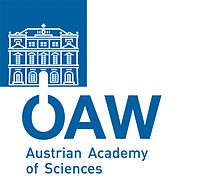Austrian Academy of Sciences
| Österreichische Akademie der Wissenschaften | |
|
Logo ÖAW | |
| Agency overview | |
|---|---|
| Formed | 1921 |
| Preceding agency |
|
| Type | National Academy |
| Jurisdiction |
|
| Headquarters | Vienna, Austria |
| Agency executives |
|
| Child agencies |
|
| Website | ÖAW Home Page |
The Austrian Academy of Sciences (in German Österreichische Akademie der Wissenschaften) is a legal entity under the special protection of the Republic of Austria. According to the statutes of the Academy its mission is to promote the sciences and humanities in every respect and in every field, particularly in fundamental research. In 2009, the Austrian Academy of Sciences was ranked 82nd among the 300 topmost research institutions in the world, based on its internet presence, by Webometrics Ranking of World Research Centers .
History
In 1713, Gottfried Wilhelm Leibniz suggested to establish such an Academy, inspired by the Royal Society and the Académie des Sciences. The "Kaiserliche Akademie der Wissenschaften in Wien" was finally established by Imperial Patent on May 14, 1847.
The Academy soon began extensive research. In the humanities the Academy started with researching and publishing important historical sources of Austria. Research in natural sciences also covered a wide variety of topics.
The 1921 federal law guaranteed the legal basis of the Academy in the newly founded First Republic of Austria. And from the mid-1960s onwards it became the country's leading institution in the field of non-university basic research.
The Academy is also a learned society, and its past members have included Christian Doppler, Theodor Billroth, Anton Eiselsberg, Eduard Suess, Ludwig Boltzmann, Paul Kretschmer, Hans Horst Meyer, Roland Scholl, Julius von Schlosser and the Nobel Prize winners Julius Wagner-Jauregg, Victor Hess, Erwin Schrödinger and Konrad Lorenz.[1]
Among the Academy's numerous publications are the Corpus Scriptorum Ecclesiasticorum Latinorum and eco.mont – Journal on Protected Mountain Areas Research and Management.
Research facilities

The Academy of Sciences has established more than 25 institutions. In 2012, a reorganization prompted the outsourcing of various institutions to Universities as well as mergers. The Academy's institutes are split into two major divisions, one for mathematics and natural sciences (mathematisch-naturwissenschaftliche Klasse) and one for humanities and social sciences (philosophisch-historische Klasse).
In the field of human science, there are the Institute for the Study of Ancient Culture, which is well-known for the analysis of excavation results in Carnuntum and Ephesos, the Institute for Interdisciplinary Mountain Research, focusing on montology, the Institute of Culture Studies and Theatre History, and the Vienna Institute of Demography, among others.
Facilities that focus on natural science include the Institute of Molecular Biotechnology (which is operated in cooperation with Boehringer Ingelheim), the Gregor Mendel Institute, the Institute of Molecular Biology, Salzburg, the Institute for Quantum Optics and Quantum Information, the Acoustics Research Institute and the Space Research Institute.
Gallery of Research
During his term as president of the Academy (1991–2003), Prof. Werner Welzig initiated the establishment of the Galerie der Forschung.[2] In 2005 the Gallery organised its pilot event "Mapping controversies: the case of the genetically modified food",[3] which was staged in the Alte Aula in Vienna.
Notes and references
- ↑ Basic information from official website
- ↑ Press release of the Austrian Academy of Sciences
- ↑ Announcement of the event on the website of the European Commission
| Wikimedia Commons has media related to Österreichische Akademie der Wissenschaften. |
Coordinates: 48°12′31″N 16°22′39″E / 48.20872°N 16.37739°E
|
